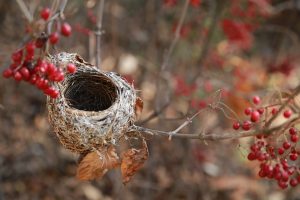A bird’s nest isn’t a year-round home, but a warm place to protect their eggs and young during the breeding season. It needs to be safe from predators and offer protection from the elements.
Have you ever wondered what birds make their nests out of and how the delicate structures manage to stay in one piece? I certainly have and was surprised to learn how each species varies their building methods and materials.
Each species of bird makes a particular type of nest utilising materials from their habitat.
They don’t imitate the nests of other birds, they simply rely on their tried and trusted methods.

Different birds prefer different nest-making materials; almost all choose to line it with something soft and protective for their eggs. Nests need to be ‘flexible’ given that they will need to expand as the hatchlings grow.
The most common materials are grasses, leaves, sticks, and twigs. Some species like to use human hair or animal fur, others opt for the softness and strength of spider’s webs and caterpillar cocoons.
Birds that nest close to the ground like to incorporate tiny stones into their structures. Some garden birds use their saliva as a bonding agent, where others prefer mud to give the nest a solid foundation.
What Common Garden Birds Make Their Nests From
Table of Contents
Finches
Most birds from the finch family choose to nest in trees or bushes 1.5 – 5m above ground. Their nests are ‘cups’ and measure about 6.5cm.
Greenfinch nests are untidy and made from dried grass, moss, twigs, baby roots, and sometimes, feathers.
Chaffinch nests are beautifully presented neat little structures. They are made from woven moss and lined with hair for softness, while the exterior is lichen and cobwebs to blend with the surroundings.
Goldfinch nests are fairly neat and made from moss. They are lined with thistledown for added comfort.
Other Garden Birds
The robin builds a slightly larger nest, around 7cm. He often assembles it close to the ground on mounds of dead leaves. Otherwise, it will never be higher than 3m and preferably well out of view, often in thick ivy or hedgerow. He uses moss and lines it with hair and tiny roots.
Long-tailed tit nests are made from moss, hair, and cobwebs. They are covered in lichen to blend in with the surroundings. Impressively, the tits can use up to 2000 feathers in the construction of a single nest.
The house sparrow prefers to nest at a great height, in trees, bushes, or the cavities of wooden structures or buildings. They usually nest in colonies making their groups of nests easier to spot. Both the males and female sparrow build their nest from grass or straw and line it with feathers. They are usually untidy affairs!
The blackbird’s nest is large and bulky, quite easy to notice. They live in bushes and hedges at heights up to 3m. They make their nest from grass and moss, they then line it with mum and cover it in fine grass.
Song thrush nests are similar in size to those of the blackbird, around 9cm. They have a very unique building style as they collect mud, rotten wood, and dung. It is cemented together with saliva and the female moulds it into the required shape using the natural curve of her breast.
How to Help the Birds with Nest-Building
Providing additional materials for the birds to make their nests might just encourage them to raise their family in your garden.
After the lawn has been mowed, there is no better material for the birds to have than the grass cuttings. If you prefer not to leave them strewn across the lawn, maybe gather a pile and leave it close to some shrubs.
Remember, grass treated with weedkiller or lawn feed may be harmful to the birds and should be disposed of safely.
After you have given your pet’s coat a brush, collect the fur and leave it in view on shrubbery. This provides the birds with perfect cushioning and protects the eggs, even when the parents are moving about on top of them.
Thin strips of cloth or wool left in full view of the birds are always welcome nesting materials.
Collect tiny sticks and twigs and leave them in a pile in an area frequented by the birds, makes their job a little easier. Some pet shops sell nest-making packs, full of materials to display around your garden.
For the birds that use mud for nesting, leaving a designated muddy patch is a treasured-find, particularly in periods of dry weather. Remember to water it regularly to keep it moist. Add soil to an upturned dustbin lid and mix with water often. This is a tidier way to provide a mud patch and can be moved around the garden.
Finally
It is useful to know what birds make their nests out of, not just for recognition purposes, but also to enable us to leave helpful materials around the garden.
With this new-found knowledge, I hope you get to see birds nesting in your garden soon.
